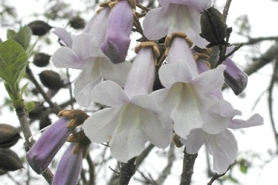Princess tree
(Paulownia tomentosa)
A rapidly growing tree in the figwort family that gets to be 30-40 feet tall. Young trees look like a pole with leaves branching off it for the first few years. It is often cut back completely when immature but grows back even taller. Twigs are covered with many white lenticels and the grayish-brown bark is thin and rough with random smooth areas.
Other names for this plant include:
- Common names: empress tree, karri tree, kiri, royal paulownia, fox-glove tree, quiri
- Scientific names: Paulownia imperialis; Bignonia tomentosa
Classification in Wisconsin: Prohibited
- Ecological Threat
-
- Grows in disturbed areas, rock outcroppings, streambanks, forest edges and roadsides.
- It can crowd out native trees due to its fast-growing nature.
- It is being used in plantations for timber production.
- It is commonly sold as an ornamental.
- Identification
-
Leaves: Simple, heart-shaped and opposite or whorled. The leaves are enormous when the tree is young but smaller when mature (five to 12 inches long and five to nine inches wide). Leaves also have long petioles and are hairy on both sides of leaves when young becoming smooth on top as the tree matures. Leaves can also be slightly lobed.
Flowers: Lavender with five petals, the bell-shaped flowers are two inches long and occur in long upright clusters. Flowers can look similar to those of foxgloves. Blooms before leaves are produced in the spring and produce a vanilla scent.
Fruits & seeds: Capsules are formed in clusters and are oval-shaped. The capsules start off light green in the summer and are sticky turning tan and drying in the winter. Each capsule contains up to 2,000 winged seeds readily dispersed by wind and water.
Roots: Roots can grow up to 15 feet in one season and have adventitious buds that can survive fire and mowing.
Similar species: Catalpa spp. (C. speciosa, C. bignonioides) have very identical shaped leaves but white flowers that produce long slender bean-like seedpods.
- Distribution
-
Currently, there have been no reports of princess trees in Wisconsin. Have you seen it? Please send us a report.
- Control
-
Mechanical: Seedlings can be hand-pulled.
Chemical: Cutting or girdling followed by applying glyphosate or triclopyr; basal bark with triclopyr.
- Resources
- Sources for content:
- Czarapata, Elizabeth; Invasive Plants of the Upper Midwest: an illustrated guide to their identification and control. The University of Wisconsin Press. 2005. Pg. 124
- Invasive Plant Atlas of New England: Princess tree [exit DNR].
- Remaley, Tom. Plant Conservation Alliance Factsheet: Princess tree [exit DNR]. Last updated July 7, 2009.



